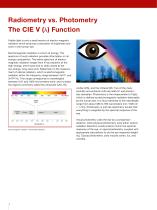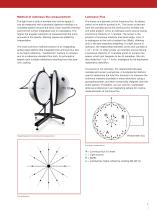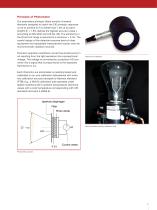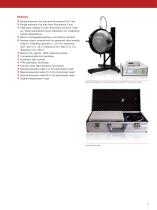
Catalog excerpts

We bring quality to light.
Open the catalog to page 1
Radiometry vs. Photometry The CIE V () Function Visible light is only a small section of electro-magnetic radiation which produces a sensation of brightness and color in the human eye. Electromagnetic radiation is a form of energy. The spectrum of such radiation provides information on its energy composition. The entire spectrum of electromagnetic radiation ranges from X-ray radiation at the high-energy, short-wave end to radio waves at the low-energy, long-wave end. Radiometry is the measurement of optical radiation, which is electromagnetic radiation within the frequency range between...
Open the catalog to page 2
In order to have also a well defined photometer, an “artificial eye” has been constructed to simulate the light sensitivity of the human eye. The relative response of the normal human eye to monochromatic light at the different spectral frequencies was determined experimentally by the CIE and standardized in 1924. This is known as the photopic luminous efficiency function. The symbol of this function is V() and it is usually expressed as a function of the wavelength of light (in air). The following procedure was conducted to determine the photopic luminous efficiency function: First, light...
Open the catalog to page 3
Intensity The candela is the basic unit in photometry. All other luminous quantities can principally be derived from it. The candela is the luminous intensity, in a given direction, of a source that emits monochromatic radiation of frequency 540x1012 Hertz and that has a radiant intensity in that direction of 1/683 Watt per Steradian. One Steradian (sr) is the solid angle that, having its vertex in the center of a sphere, segments an area on the surface of the sphere equal to that of a square with sides of length equal to the radius of the sphere. The candela is abbreviated as cd and its...
Open the catalog to page 4
Method of luminous flux measurement Luminous Flux The light from a bulb is emitted into infinite space. It can be measured with a photopic detector rotating in a complete sphere around the lamp. Each discrete intensity point (lm/sr) is then integrated over 4π steradians. The higher the angular resolution of measurement the more accurate is the results. Missing values are added by interpolation. The lumen is a derived unit for luminous flux. Its abbreviation is lm and its symbol is v. The lumen is derived from the candela and is the luminous flux emitted into unit solid angle (1 sr) by an...
Open the catalog to page 5
Illuminance Illuminance is another quantity derived from intensity which denotes luminous flux density. It has a special name, lux, and is lumen per square meter, or lm/m2. The symbol is Ev. Most light meters measure this quantity, as it is of great importance in illumination engineering. Some examples for typical illuminances range from 100,000 lx for direct sunlight, or 500 lx on a working desk in office to 20-50 lx for hospital corridors at night and 1 lx for emergency lighting. Luminance is the only photometric quantity that can be visually seen by human beings (except starlight)....
Open the catalog to page 6
Principle of Photometer Our proprietary photopic filters consist of several elements designed to match the CIE photopic response l curve to achieve an f1 to better than 1.5% at all wavel lengths (f1 < 1.5% defines the highest accuracy class L according to DIN 5032 and CIE No. 69). The sensitivity in the IR and UV range is reduced to a minimum < 0.1%. The careful design of the detectors ensures best-of-class equipment and repeatable measurement results, even for monochromatic radiation sources. Precision operation amplifiers convert the photocurrent in nA resulting from the light sensation...
Open the catalog to page 7
Digilux 9500 The Digilux 9500 is a precision luxmeter that enables convenient measurement of illuminance in a laboratory or on the production floor. Incorporating the latest amplifier and microprocessor technology, this instrument offers operating and display functions never seen in its class and an excellent price performance ratio. The precision photometer head, with V() filter, is thermostabilized. It can be delivered in different versions, with an inhouse test report or optionally with PTB (Federal Institute for Physics and Technology) test report. Standard: DIN 5032-7, class L/A, CIE...
Open the catalog to page 8
Options Range extension for low level illuminance 0.01 mlx Range extension for high level illuminance 2 mlx Digilumen: display of both illuminance and flux; fixed lux, freely selectable lumens calibration for integrating sphere applications Built-in rechargeable battery, low battery indicator Analog output: proportional to measured value analog output in following versions: 0...20 mA, resistance max. 400 ½; 0...10 V, resistance min. 500 ½; 0...5 V, resistance min. 500 ½ Memory for approx. 1000 measured values programmable limit switches 4 Automatic light control PTB...
Open the catalog to page 9
DSP 10 Photometer / AMS Controller The AMS Controller has been originally designed for fast goniophotometric measurement in conjunction with the well established family of Optronik Line goniometers. Up to 8 DSP 10 preamplifiers can be connected, each disposing of an individual calibration available in lx, cd or cd/m2. The precision photometer head, with V() filter, is thermostabilized. It can be delivered with an inhouse test report or optionally with PTB (Federal Institute for Physics and Technology) test and calibration report. Standard: DIN 5032-7, class L/A, CIE 69, DIN-EN 13032-1....
Open the catalog to page 10
Measurement principle Additional measurement distances (e.g. 3.162, 5, 10, 15, 25 m) Tube for stray light reduction Tripod Separate 19” bench top housing Flash measurement LightCon software for light measurement, data pro cessing, evaluation, and graphical representation in different formats precision V()-(photopic) matched photometer head A produces a photo-current that is proportional to the illuminance on the light sensitive surface. This photocurrent is fed to the DSP 10, where it is converted into a proportional voltage by a gain controlled amplifier with a wide...
Open the catalog to page 11All Instrument Systems catalogs and technical brochures
-
VTC 2400
2 Pages
-
CAS 125-HR
2 Pages
-
ITS Integrating Spheres
12 Pages
-
CAS 125 Array Spectrometer
4 Pages
-
SpecWin Pro software
12 Pages
-
LEDGON 100
4 Pages
-
Products & Solutions
16 Pages

































